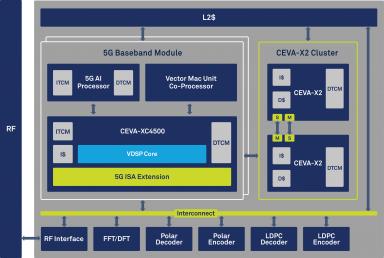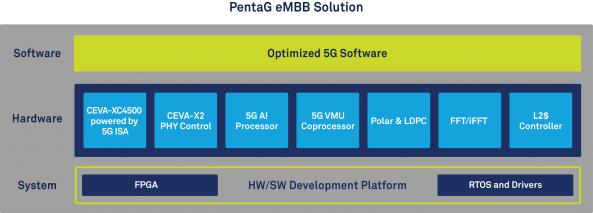If you’re not up-to-speed on 5G, there are three use-cases: eMBB(enhanced mobile broadband) for mobile platforms (Gbps rates, immersive gaming, VR, AR – spectrum usage also extends up to mmWave, but that’s a different topic), mMTCfor massive machine type communication (ultra-low cost, ultra-low power, very dense networks) and URLLC or ultra-reliable low latency communication (for tele-surgery, traffic safety and aspects of industrial automation). CEVA is announcing their PentaG platform in support of eMBB at Mobile World Congress (MWC) next week.

Leveraging their skills in DSP IP, CEVA has built considerable experience and product road-time in wireless standards support, from 2G on up, and are now at 9B+ devices shipped to date across their product lines. Which means they already have a lot of credibility with the handset and base-station OEMs who are preparing for 5G. I blogged last year (One Cellular Technology to Rule Them All) on their work in this area in support of base-stations. Now they’re announcing what they’re doing in support of UEs (user-equipment aka mobile devices to the rest of us).
Enhanced Mobile Broadband (eMBB) is a tough standard to support; versus LTE it requires much higher capacity and bandwidth, much lower latency, multi-mode/RAT support for smooth evolution / coexistence with existing standards, and support for massive MIMO – multi antennas at both base-station and UE. But looks like it will be worth the effort. CCS Insight expects 1B subscribers by 2023 and 2.5B by 2025. The network operators, handset makers and semis are already actively engaging, most in support of the 5G-NR priority while Verizon apparently is still doing its own thing (with support from some cities and countries) in the mmWave part of the standard.
Emmanuel Gresset (Director Biz Dev in the CEVA Wireless Unit) told me that an important aspect in providing support for 5G in these relatively early days when the standard is still evolving is to balance between performance and flexibility. They put a lot of effort into looking at tradeoffs, and in ability for customers to reuse legacy software with enhancements only where needed for eMBB. He cited as an example their choice to use the already widely-deployed XC4500 in the Vector MAC unit processor (VMU). This has 64 MACs versus their XC12 with more MACs but the XC12 solution might have implied more software rework for existing customers. Instead they added extensions to the 4500 architecture to support 5G with minimal disruption to legacy code (and they incidentally pick-up the MAC shortfall in the VMU).
One part of the PentaG solution I found especially interesting is an AI processor based on neural nets which they use for link adaptation. Adaptation is a phase where the UE and the base-station communicate to optimize the quality of the link; the base-station sends information, the UE receives and looks at all options to optimize that signal, then sends back to the base-station to guide reconfiguring the link.
In earlier standards, the UE method to decide how to optimize was algorithmic. As standards evolved this had to be extended to algorithms plus lookup tables tuned to needs. As standards evolved further (LTE-Advanced), those tables had to grow significantly to meet link quality expectations. For CEVA it was very unclear that this approach could scale into 5G without loss in quality, hurting both transmission rates and power. PentaG instead uses a neural net approach which can be trained (by the OEM) to optimize adaptation. CEVA demonstrate this in improved throughput and significantly reduced power over their earlier-generation (LTE-A) solution. They also believe this approach will be much more flexible in adjusting to evolution in the 5G standard.
The VMU is designed to handle the massive MIMO requirement of 5G where you have a greatly increased number of antennas on the base-station and on the UE, resulting in 5X the channel bandwidth to be processed that you have in LTE. 5G MIMO also means that the UE has to deal with 10X the beamforming options it had to handle in LTE. The VMU assists here, through parallelism, a matrix engine and yet more MAC processing, again providing higher performance and lower power than earlier generation solutions.
A cluster of CEVA-X2 DSPs optimizes modem control for latency and performance across multi-RAT/5G and multiple simultaneous events. It also provides an optimized connect solution/queue manager to manage traffic housekeeping between units directly without needing to get bogged down in interrupt-driven transfers – yet again important in managing throughput and latency to 5G expectations.

Finally, the platform – and it is a platform, multiple IPs and software – offers a set of hardware accelerators for the encode and decode functions required for 5G: polar and LDPC. They also offer software libraries optimized for 5G (also for LTE-A / WCDMA / TD-SCDMA) and a HW/SW development kit with reference board. The software also includes the AI training suite that an OEM would use to train the neural nets. Emmanuel stressed that PentaG is not a full modem – you still have to add RF and cache for example. But it certainly seems to be the heart and soul of a 5G eMBB modem.
At MWC next week, CEVA will be showing an impressive demo based on a UE with 4 antennas and a base-station with 8 antennas. The UE will be in a car driving in the city, among high rises with quickly varying reception, at times with no line of sight to the base-station. They’ll show how actual reception/transmission rates compare to theoretical optimum values. Sounds like they’re pretty confident. You can learn more about PentaG HERE. If you want to learn more about 5G in general, there’s a useful reference HERE.
Share this post via:





Comments
There are no comments yet.
You must register or log in to view/post comments.